Welcome to our blog on Polyhouse Farming in India! If you’re curious about modern agricultural practices that are revolutionizing how crops are grown, you’re in the right place. Polyhouse farming is gaining popularity in India due to its many advantages. It involves cultivating plants within a controlled environment protected from external factors such as pests, harsh weather conditions, and diseases. This innovative farming technique allows farmers to extend the growing season, increase crop yield, and ensure better-quality produce.
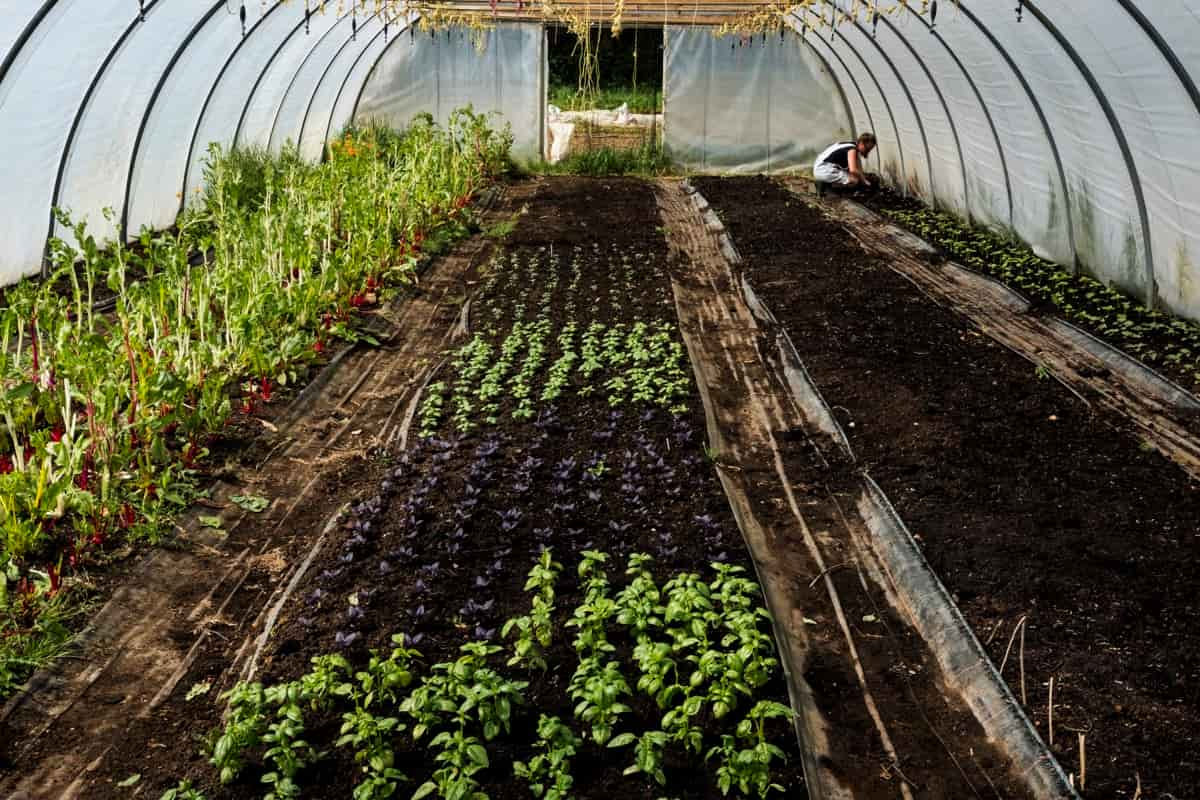
What is Polyhouse Farming in India?
Polyhouse farming involves cultivating plants within a controlled environment using transparent materials such as glass or polyethylene. Depending on the requirements, these structures can vary in size, from small shacks to large buildings. Greenhouses, including polyhouses, harness sunlight to warm up the interiors while preventing the escape of greenhouse gases.
Compared to a greenhouse, a polyhouse is a smaller version with a polyethylene cover. Polyhouse farming is popular in developing countries like India due to its affordability and ease of maintenance. However, traditional greenhouses, such as those using wood covers, are more durable but costlier.
Different Types of Polyhouse in India
Naturally Ventilated Polyhouse: Traditional and basic, it relies on natural ventilation and features limited control mechanisms for climate conditions like irrigation, foggers, and ventilation systems. It influences the crop cycle and production but does not control external conditions completely.
Environmentally Controlled Polyhouse: This sophisticated type offers advanced control over humidity, temperature, and sunlight. It enables extended crop periods and allows for the cultivation of exotic off-season crops, making it a modern and versatile option.
Low-Tech Cheap Polyhouse: Simple and cost-effective, it uses locally available materials like bamboo with UV-stabilized cladding. It provides shelter during heavy rainfall and utilizes shade to regulate light penetration.
Moderate-Tech Polyhouse: Durable and resilient, it uses galvanized iron pipes for construction. Equipped with thermostats and exhaust systems, it offers better protection against harsh weather conditions. Suitable for dry climate areas, it requires regular maintenance.
High-Tech Polyhouse: The most advanced type, it incorporates cutting-edge technologies and automated systems to control various aspects within the polyhouse.
In case you missed it: From Deserts to Harvests: Greenhouse Farming in Saudi Arabia
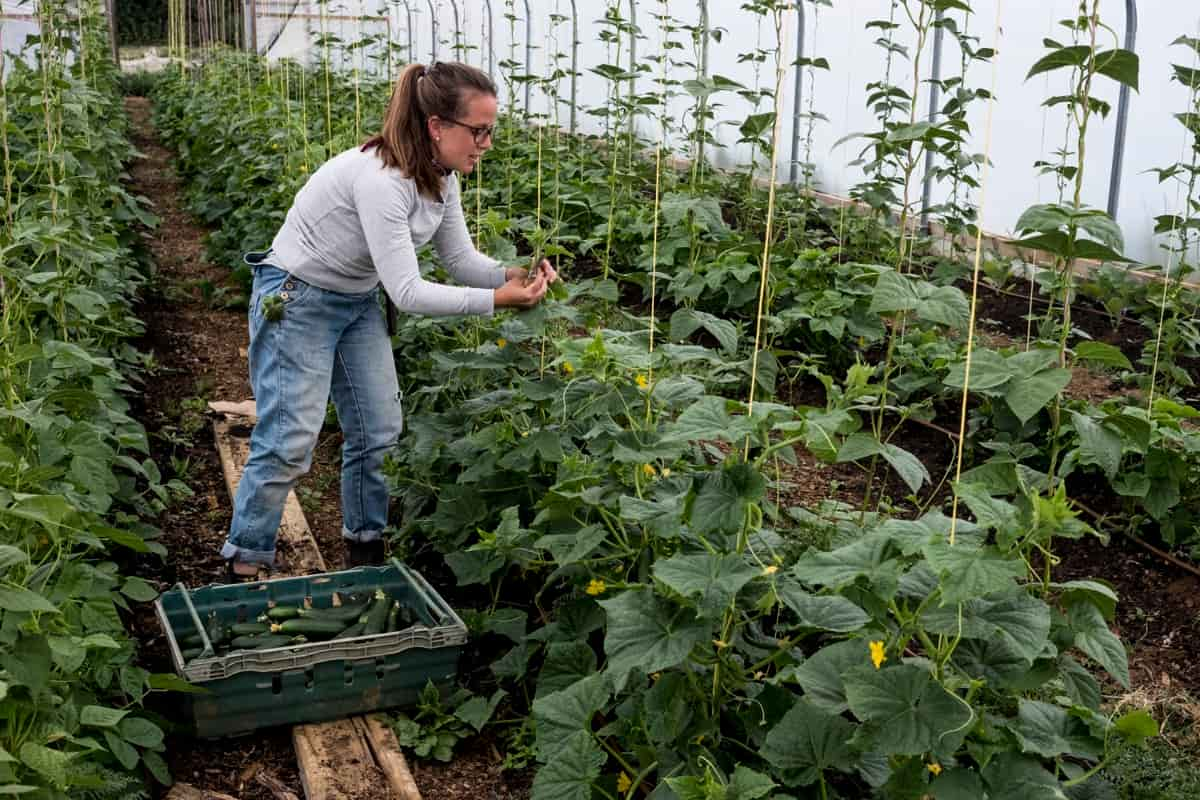
Benefits of Polyhouse Farming in India
High-Quality Produce: Polyhouse farming ensures the production of high-quality crops. With controlled climatic conditions, farmers can monitor and manage the growth of plants, ensuring optimal water and nutrient supply. This control results in superior quality products in high demand in the market.
Climate Control: In regions with extreme temperatures, a polyhouse provides a solution. By regulating variables such as temperature, humidity, and air ventilation, polyhouses create a favorable environment for crop production, even in areas with unfavorable climatic conditions.
Vertical Crop Cultivation: Polyhouses enable vertical farming, utilizing space efficiently. Crops like cucumbers and indeterminate tomatoes can be grown vertically, increasing crop yield by up to 3 to 4 times.
Increased Yield and Productivity: Polyhouse farming is designed to maximize crop production. By implementing modern techniques like aeroponics and hydroponics and maintaining optimal conditions, farmers can achieve yield increases of 10-12 times per unit area compared to traditional farming.
Polyhouse Farming Cost in India
Polyhouse construction costs in India vary depending on the type of polyhouse chosen. The lowest cost is around Rs. 600 per square meter for a tunnel form polyhouse, while a naturally ventilated polyhouse without automation ranges from Rs. 800 to Rs. 900 per square meter. High-tech polyhouses with modern machinery and full automation can cost up to Rs. 4,000 per square meter, starting from around Rs. 2,000 per square meter. The net profit from a polyhouse in India can range from 8 to 20 lakhs per acre per annum, depending on the crops grown.
- Construction: The construction cost primarily depends on the size of the polyhouse and the material used for its framework. Galvanized iron (G.I.) pipes are typically preferred for durability and affordability.
- Covering Material: The choice of covering material, such as UV-stabilized poly film or polycarbonate sheets, affects the cost. Polyfilm is a cost-effective option, while polycarbonate offers higher durability but comes at a higher price.
- Infrastructure: Infrastructure components like irrigation systems, ventilation equipment, and shade nets are necessary for efficient polyhouse farming. These contribute to the overall cost.
- Technology and Automation: Implementing advanced technology and automation systems for climate control, irrigation, and monitoring can increase initial investment but improve productivity and resource management.
- Operational Costs: Ongoing expenses include labor, fertilizers, seeds, utilities, and maintenance. These costs vary depending on the crop type and scale of operations.
Considering all the above factors, the cost of a medium-sized commercial polyhouse in India can range from INR 10 lakhs to INR 50 lakhs or more, based on the type of polyhouse.
Polyhouse Farming Subsidies in India
In India, the government encourages polyhouse farming and offers subsidies through the horticulture department. These subsidies can significantly reduce the initial investment required for a polyhouse. Farmers must gather project information and required documents to apply for a subsidy and secure a bank loan to apply for a subsidy.
Subsidy percentages vary from state to state and can cover a significant portion of the polyhouse project cost, ranging from 50% to 60%. By understanding the subsidy application process and gathering the necessary documentation, farmers can use government support to make polyhouse farming more accessible and financially viable in India.
In case you missed it: Earning 1.3 Lakh Rupees from Coriander Cultivation in Polyhouse: A Success Story from Herbal Farming
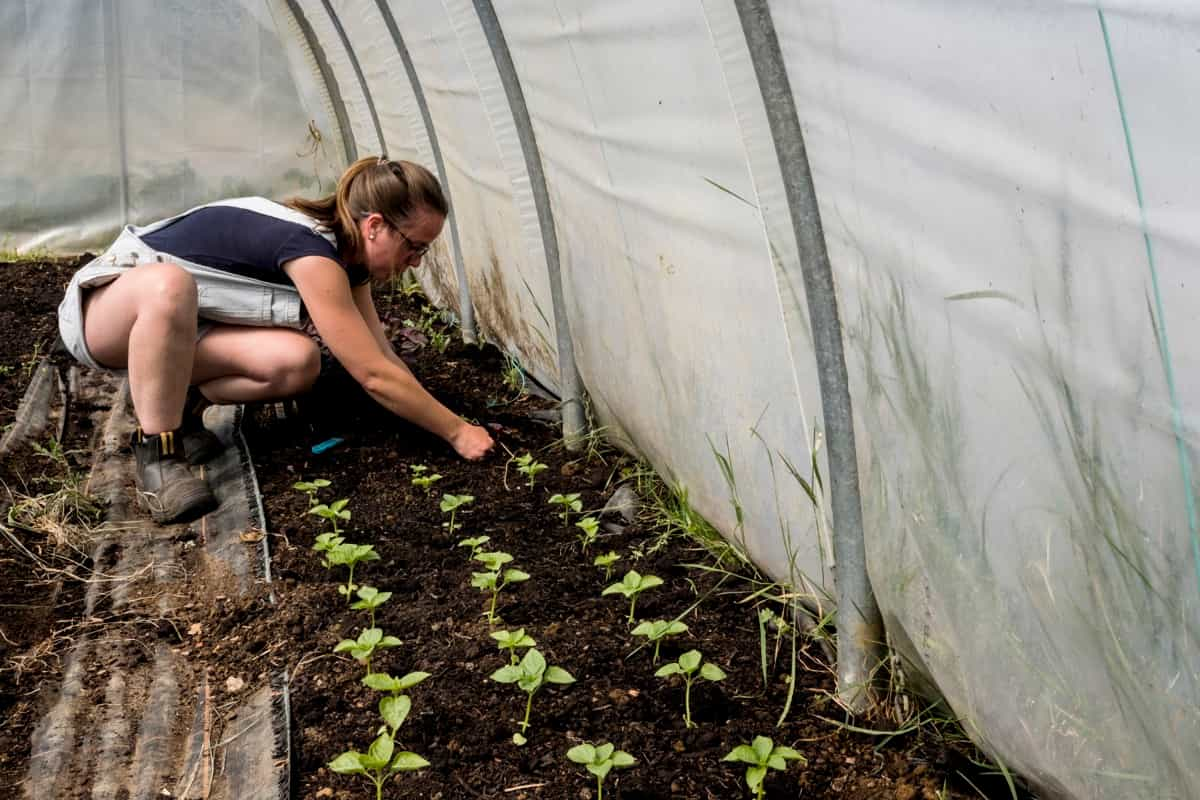
- The government of India offers subsidies to farmers who set up polyhouses.
- The subsidy amount varies from state to state, but it can be as high as 80% of the project cost.
- To qualify for the subsidy, farmers must meet certain eligibility criteria, such as having a minimum landholding size and using approved polyhouse materials.
- The subsidy can cover the polyhouse construction, equipment, and inputs cost.
Polyhouse Farming Equipment Suppliers in India
India has suppliers that offer a wide range of polyhouse farming equipment, including greenhouse structures, poly film covers, irrigation systems, ventilation equipment, shade nets, and other essential tools. Polyhouse farming equipment suppliers include K.S. Plastic Industries, Kumar Agro Industries, Jain Irrigation Systems Ltd., P. J. Plastics, SAI Technology, National Agro Industries, Kasan Agro Net Industries, Solanki Agricultural Equipments, Green Agro Tech, Netafim India.
These suppliers provide high-quality, durable products suitable for polyhouse farming operations. To ensure reliable and efficient equipment, thorough research, price comparison, and customer reviews are essential.
Polyhouse Farming Techniques in India
Polyhouse farming in India utilizes various techniques to create optimal crop growth conditions. Key techniques include climate control systems, drip irrigation, nutrient management, crop rotation, integrated pest management (IPM), and vertical farming. Climate control systems regulate temperature, humidity, and ventilation, while drip irrigation systems provide water directly to plant roots, minimizing water wastage and optimizing water efficiency.
Nutrient management techniques, such as hydroponics and fertigation, ensure efficient absorption and minimize nutrient loss. Crop rotation maintains soil health and prevents pest buildup, while IPM techniques minimize chemical pesticide use. Vertical farming techniques maximize space utilization, allowing crops like tomatoes and cucumbers to grow vertically, increasing yield per unit area.
Polyhouse Farming Training Programs in India
Training programs in India provide valuable knowledge and practical skills in polyhouse farming techniques and principles. These programs cover greenhouse construction, climate control, irrigation systems, crop selection, pest and disease management, nutrient management, and marketing strategies. Expert guidance, workshops, and field visits expose participants to real-life polyhouse setups and successful farming practices, allowing them to understand the industry better. Certifications validate participants’ knowledge and skills.
- All India Organic Farmers Society (AIOFS) conducts training sessions on polyhouse and greenhouse farming across India.
- Krishi Vigyan Kendra KVK, with branches in various states, periodically organizes training programs on polyhouse farming. Visit their official website or contact the nearest KVK center for training schedules.
- Numerous other institutes and organizations provide training on commercial polyhouse cultivation. Seek recommendations from experienced polyhouse farmers or consult KVK for additional training opportunities.
Attending these training programs, typically lasting for a few days, will equip you with essential knowledge about crop selection, management practices, irrigation techniques, and more. These programs may have a nominal fee, but the knowledge gained will be invaluable for starting and succeeding in commercial polyhouse farming.
Polyhouse Farming Vs. Traditional Farming in India
Polyhouse farming in India offers higher crop yields and productivity due to controlled environments, optimized resource management, and advanced techniques like vertical farming. Farmers can achieve yield increases of 10-12 times per unit area compared to traditional farming.
This leads to improved crop quality, water and resource efficiency, climate resilience, and efficient land utilization through vertical farming and crop rotation practices. Despite initial cost-effectiveness, polyhouse farming provides greater control, productivity, and sustainability, making it a viable option for modern agricultural practices in India.
Polyhouse Farming for Vegetable Cultivation in India
Polyhouse farming in India offers excellent opportunities for vegetable cultivation. By employing polyhouse farming techniques, farmers in India can enjoy year-round production, better crop quality, and increased market demand for these key vegetable crops.
In case you missed it: Earning 1.5 Lakh from Gerbera Cultivation in Polyhouse: A Success Story of a Farmer in India
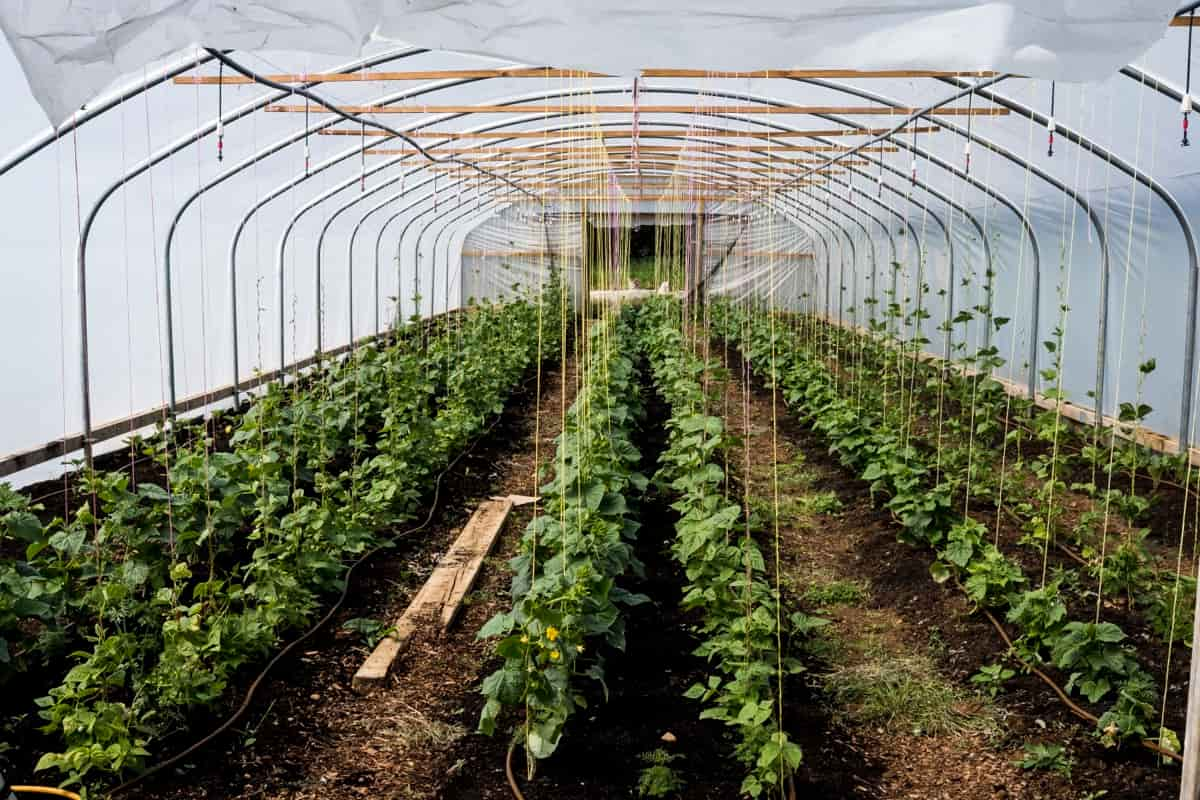
Capsicum: Capsicum, or bell peppers, thrive in controlled environments provided by polyhouses. Consistent climate control ensures optimum growth and higher yields of capsicum varieties, including green, red, and yellow.
Tomatoes: Tomatoes are highly suited for polyhouse farming. With proper temperature, humidity, and irrigation management, polyhouses enable year-round tomato cultivation, resulting in improved quality and extended harvesting seasons.
Chillies: Chilli crops benefit from the protection provided by polyhouses. The controlled environment helps manage pests and diseases, leading to healthier plants and higher yields of various chilli varieties.
English Cucumber: Cucumber varieties flourish in polyhouses due to the regulated climate conditions. The controlled environment ensures optimal growth, resulting in uniform and high-quality cucumbers.
Leafy Vegetables: Polyhouse farming is particularly advantageous for leafy vegetables like lettuce, spinach, and kale. The controlled environment allows for better disease control, faster growth, and higher nutrient content in the harvested leaves.
Polyhouse Farming for Flower Cultivation in India
Chrysanthemum: Chrysanthemums are highly sought-after flowers known for their vibrant colors and long vase life. Polyhouse farming enables precise control over temperature, humidity, and light, producing high-quality chrysanthemum blooms.
Gerbera: Gerberas are popular for their large, colorful blooms and long-lasting freshness. In a polyhouse, farmers can create optimum conditions for gerbera cultivation, ensuring consistent quality and abundant production.
In case you missed it: A Guide to Understand Polyhouse Farming: Check How this Helps Protected Cultivation of Beginners
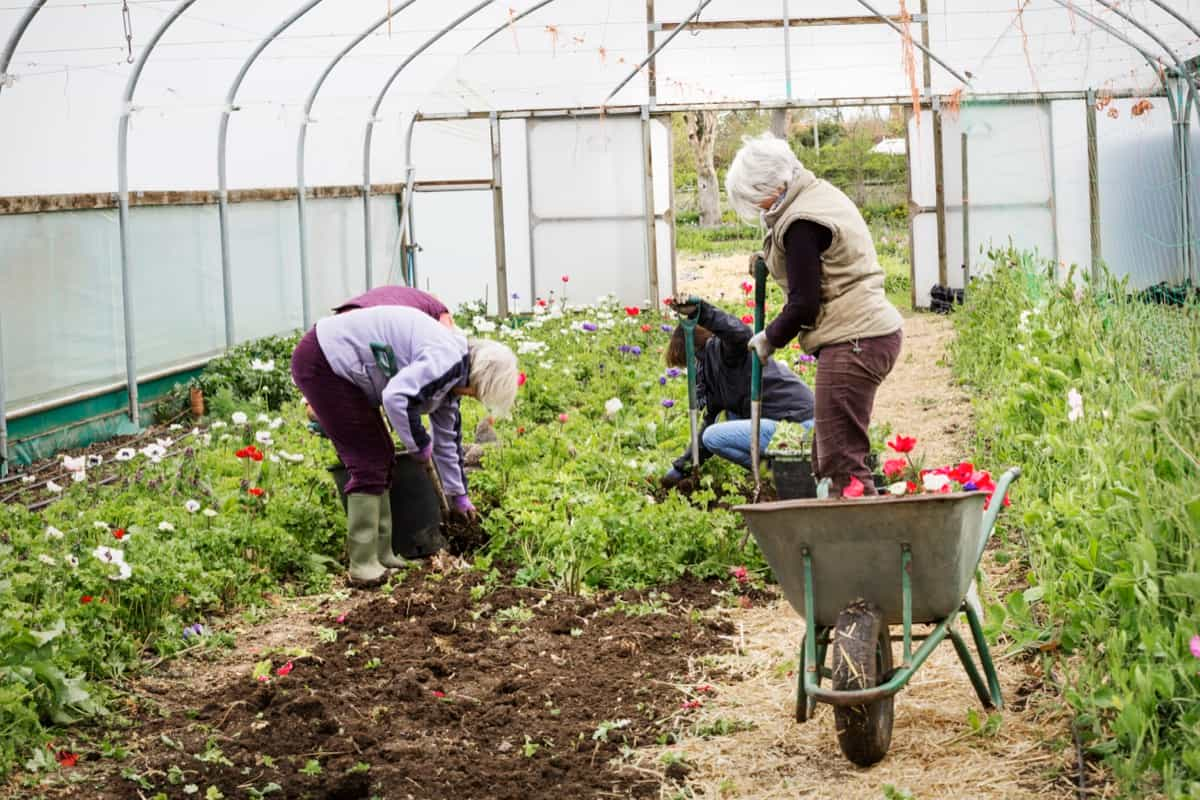
Orchid: Orchids are delicate and exotic flowers that thrive in the controlled environment of a polyhouse. With proper temperature and humidity management, polyhouse farming successfully cultivates various orchid species, catering to the growing demand.
Rose: Roses are timeless symbols of love and beauty. Polyhouse farming provides an advantage by protecting rose plants from pests and diseases, resulting in healthier plants and superior-quality blooms.
Carnation: Carnations are popular for their diverse colors and fragrance. Polyhouse farming ensures precise temperature and humidity control, enabling year-round cultivation and a consistent supply of vibrant carnation flowers.
Polyhouse Farming for Medicinal Plant Cultivation in India
Polyhouse farming provides an excellent opportunity for cultivating medicinal plants in India. With controlled environments and optimal growing conditions, polyhouses offer enhanced plant growth and medicinal properties. Some popular medicinal plants suitable for polyhouse farming in India include Tulsi (Holy Basil), Ashwagandha, Aloe Vera, Stevia, Brahmi, and Giloy.
Due to their medicinal value, these plants have high demand in the pharmaceutical and herbal industries. Polyhouse farming allows for year-round cultivation, ensuring a consistent supply of high-quality medicinal plants. It also enables farmers to meet the growing demand for natural remedies and herbal products, contributing to health and economic benefits.
Polyhouse Farming for Fruit Cultivation in India
Polyhouse farming provides a unique opportunity for Indian fruit cultivation, enabling farmers to grow a wide range of fruits with improved quality and yield. Some fruits well-suited for polyhouse farming include raspberries, strawberries, muskmelon, peach, papaya, grapes, pomegranate, and bananas.
In case you missed it: Earning 70 Lakhs from Rose Cultivation in 5 Acre Polyhouse: The Success Story of a Flower Farmer

These crops thrive in controlled environments, requiring consistent temperature and moisture levels, allowing for optimized growing conditions and protection against pests and diseases. Polyhouse farming also offers protection against wind, pests, and diseases, resulting in higher yields. By adopting polyhouse farming techniques, farmers can increase profitability and sustainability in fruit cultivation in India.
Polyhouse Farming for Organic Crop Production in India
Polyhouse farming provides an ideal platform for organic crop production in India. With controlled environments, polyhouses offer protection against pests and diseases, reducing the reliance on chemical interventions. Organic farming practices such as nutrient management, crop rotation, and integrated pest management can be implemented effectively in polyhouses. This promotes sustainable agriculture by minimizing environmental impact, ensuring chemical-free produce, and meeting the growing demand for organic crops.
Polyhouse Farming for High-value Crop Cultivation in India
Polyhouse farming offers India lucrative opportunities for cultivating high-value crops, including cherry tomatoes, bell peppers, English cucumbers, exotic herbs, salad greens, strawberries, microgreens, orchids, medicinal herbs, and colorful capsicums. These crops cater to niche markets, fetch better returns, and enhance agricultural profitability. Polyhouse farmers can tap into niche markets by focusing on these crops, increasing returns, and enhancing their agricultural ventures.
Polyhouse Farming Challenges and Solutions in India
Polyhouse farming in India presents challenges, including high initial investment, climate control, pest and disease management, irrigation management, nutrient management, crop selection and management, and market access. However, these challenges can be addressed through various strategies. Farmers can explore government schemes and subsidies, seek bank loans, and collaborate with other farmers to manage initial investments.
Installing climate control systems, adopting IPM techniques, implementing efficient irrigation systems, conducting soil testing, and practicing proper crop selection and rotation can overcome other challenges. Building relationships with local retailers, participating in farmer markets, and utilizing online platforms can help farmers access appropriate markets.
Government Policies and Initiatives for Polyhouse Farming in India
The Indian government has introduced different policies and initiatives to support and promote polyhouse farming in the country. Key highlights include the National Horticulture Mission (NHM), Pradhan Mantri Krishi Sinchayee Yojana (PMKSY), Rashtriya Krishi Vikas Yojana (RKVY), and National Horticulture Board (NHB).
These policies aim to enhance productivity, promote sustainable practices, and improve the livelihoods of farmers involved in polyhouse farming. These initiatives focus on efficient water management, drip and sprinkler irrigation systems, and the adoption of modern technologies, such as polyhouse farming.
Conclusion
Polyhouse farming in India offers significant benefits such as increased crop productivity, quality control, and climate resilience. With supportive government policies and technological advancements, polyhouse farming presents a promising avenue for sustainable and profitable agriculture in the country.
- Types of Pesticides Used in Agriculture: A Beginner’s Guide
- Economical Aquaculture: A Guide to Low-Budget Fish Farming
- 15 Common Planting Errors That Can Doom Your Fruit Trees
- How to Make Houseplants Bushy: Effective Tips and Ideas
- Innovative Strategies for Boosting Coconut Pollination and Yield
- Pollination Strategies for Maximum Pumpkin Yield
- The Complete Guide to Chicken Fattening: Strategies for Maximum Growth
- Natural Solutions for Tulip Problems: 100% Effective Remedies for Leaf and Bulb-Related Issues
- Revolutionizing Citrus Preservation: Towards a Healthier, Greener Future
- Natural Solutions for Peony Leaf and Flower Problems: 100% Effective Remedies
- Maximizing Profits with Avocado Contract Farming in India: A Comprehensive Guide
- Natural Solutions for Hydrangea Problems: 100% Effective Remedies for Leaf and Flowers
- The Ultimate Guide to Choosing the Perfect Foliage Friend: Bringing Life Indoors
- From Sunlight to Sustainability: 15 Ways to Use Solar Technology in Agriculture
- The Ultimate Guide to Dong Tao Chicken: Exploring from History to Raising
- The Eco-Friendly Makeover: How to Convert Your Unused Swimming Pool into a Fish Pond
- Mastering the Art of Delaware Chicken Farming: Essentials for Healthy Backyard Flocks
- 20 Best Homemade Fertilizers for Money Plant: DIY Recipes and Application Methods
- How to Craft a Comprehensive Free-Range Chicken Farming Business Plan
- Brighten Your Flock: Raising Easter Egger Chickens for Beauty and Bounty
- How to Optimize Your Poultry Egg Farm Business Plan with These Strategies
- Subsidy for Spirulina Cultivation: How Indian Government Schemes Encouraging Spirulina Farmers
- Ultimate Guide to Raising Dominique Chickens: Breeding, Feeding, Egg-Production, and Care
- Mastering the Art of Raising Jersey Giant Chickens: Care, Feeding, and More
- Ultimate Guide to Raising Legbar Chickens: Breeding, Farming Practices, Diet, Egg-Production
- How to Raise Welsummer Chickens: A Comprehensive Guide for Beginners
- How to Protect Indoor Plants in Winter: A Comprehensive Guide
- Ultimate Guide to Grow Bag Gardening: Tips, Tricks, and Planting Ideas for Urban Gardeners
- Guide to Lotus Cultivation: How to Propagate, Plant, Grow, Care, Cost, and Profit
- Agriculture Drone Subsidy Scheme: Government Kisan Subsidy, License, and How to Apply Online
- Ultimate Guide to Raising Araucana Chickens: Breed Profile, Farming Economics, Diet, and Care
- Bringing Hydroponics to Classroom: Importance, Benefits of Learning for School Students
- Ultimate Guide to Raising Polish Chickens: Breed Profile, Farming Economics, Diet, and Care
- Ultimate Guide to Raising Australorp Chickens: Profile, Farming Economics, Egg Production, Diet, and Care
- Silkie Chicken Farming: Raising Practices, Varieties, Egg Production, Diet, and Care
- Sussex Chicken Farming: Raising Practices, Varieties, Egg Production, Diet and Care